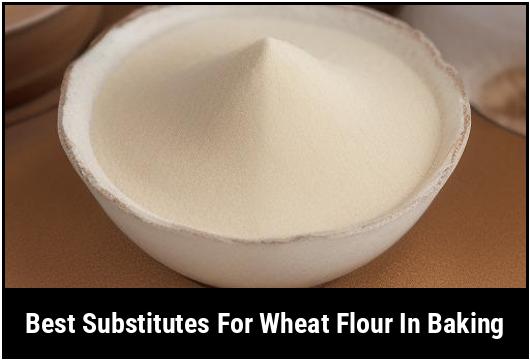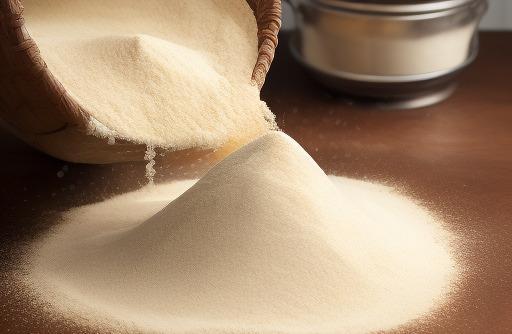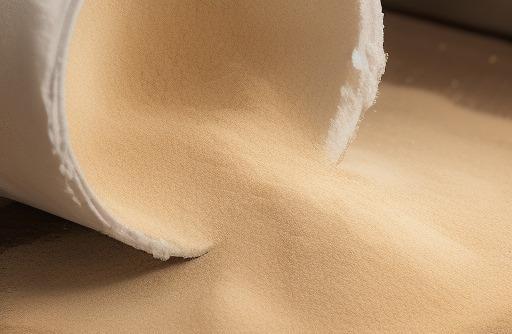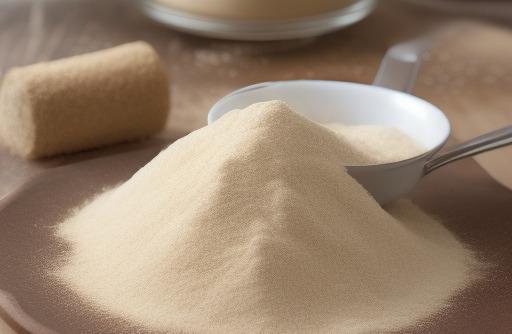Best Substitutes For Wheat Flour In Baking

Wheat flour is a commonly used ingredient in baking, but what do you do if you or someone you’re baking for has a gluten intolerance or allergy? Luckily, there are several alternatives to wheat flour that can be used in baking to achieve similar results. In this article, we will explore the best substitutes for wheat flour, how to choose the right one for your needs, and provide some delicious recipes to try.
Key Takeaways
- Wheat flour can be substituted with a variety of alternatives in baking.
- Nut flours, such as almond or hazelnut flour, can add a rich flavor to baked goods.
- Gluten-free flour blends are a convenient option for those with gluten sensitivities or allergies.
- Experiment with different ratios and combinations of substitutes to achieve the desired texture and taste.
Why You Need A Substitute For Wheat Flour In Baking
There are several reasons why you might need to find a substitute for wheat flour in your baking:
-
Gluten Intolerance or Allergy: Wheat flour contains gluten, which can cause digestive issues and allergic reactions in some individuals. Those with gluten intolerance or celiac disease must avoid wheat flour altogether.
-
Dietary Preferences: Some people choose to follow a gluten-free diet for various reasons, such as weight management or pursuing a healthier lifestyle.
-
Variety and Flavor: Using alternative flours can provide unique flavors and textures to your baked goods, adding a delicious twist to traditional recipes.
-
Nutritional Benefits: Many substitutes for wheat flour, such as almond or coconut flour, offer additional nutritional benefits, including higher protein content and healthy fats.
Types Of Substitutes For Wheat Flour In Baking

When looking for a substitute for wheat flour in baking, consider the following options:
-
Alternative Grain Flours: These flours are made from grains other than wheat, such as corn, rice, or oat flour. They can be used as a one-to-one replacement for wheat flour in most recipes.
-
Nut Flours: Made from ground nuts, such as almonds, hazelnuts, or pecans, nut flours add a rich flavor and moist texture to baked goods.
-
Bean Flours: Bean flours, such as chickpea or black bean flour, are high in protein and fiber. They can be used in conjunction with other flours or as a standalone substitute.
-
Gluten-Free Flour Blends: These blends are a convenient option for those who want an all-in-one gluten-free flour alternative. They typically consist of a combination of gluten-free flours and starches, such as rice flour, tapioca flour, or potato starch.
-
Coconut Flour: Made from dried coconut meat, coconut flour is rich in fiber and adds a subtle coconut flavor to baked goods.
-
Quinoa Flour: Quinoa flour is made from ground quinoa seeds. It has a mild, nutty flavor and is a good source of protein and fiber.
-
Buckwheat Flour: Despite its name, buckwheat is not related to wheat and is gluten-free. Buckwheat flour has a unique, earthy taste and is often used in pancakes, waffles, and bread.
Best Substitutes For Wheat Flour In Baking

Here are some of the best substitutes for wheat flour in baking, along with their characteristics and suitable uses:
1. Alternative Grain Flours
-
Rice Flour: Rice flour is a versatile gluten-free flour that can be used in a variety of recipes, including cakes, cookies, and bread. It has a mild flavor and produces slightly crumbly textures in baked goods.
-
Corn Flour: Corn flour is finely ground from dried corn kernels. It is commonly used in bread, tortillas, and cornbread recipes. It has a slightly sweet and earthy flavor.
-
Oat Flour: Made by grinding oats, oat flour adds a subtle nutty flavor to baked goods. It works well in cookies, cakes, and bread. Be sure to use certified gluten-free oat flour if you need to avoid gluten.
2. Nut Flours
-
Almond Flour: Almond flour is made from finely ground blanched almonds. It has a subtle, nutty flavor and adds moisture and tenderness to baked goods. Almond flour is commonly used in macarons, cookies, and crusts.
-
Hazelnut Flour: Hazelnut flour, also known as filbert flour, has a rich, nutty flavor that pairs well with chocolate and fruits. It can be used in cakes, cookies, and muffins.
3. Bean Flours
-
Chickpea Flour: Chickpea flour, also known as gram flour or besan, can be used as a substitute for wheat flour in recipes such as pancakes, fritters, and bread. It has a slightly nutty flavor and adds a dense texture to baked goods.
-
Black Bean Flour: Black bean flour is high in protein and fiber and has a slightly earthy taste. It pairs well with chocolate and can be used in brownies, cookies, and cakes.
4. Gluten-Free Flour Blends
-
Bob’s Red Mill Gluten-Free 1-to-1 Baking Flour: This blend is specifically formulated to substitute wheat flour in a one-to-one ratio in most recipes. It is made from a combination of rice flour, potato starch, tapioca flour, and xanthan gum.
-
King Arthur Gluten-Free Measure for Measure Flour: Similar to the previous blend, this flour can be used as a direct replacement for wheat flour in most recipes without any adjustments. It is a versatile blend made from a combination of rice flour, tapioca flour, potato starch, and xanthan gum.
5. Coconut Flour
- Coconut Flour: Coconut flour is highly absorbent, so it requires more liquid in recipes. It adds a subtle sweetness and moisture to baked goods. Use it in muffins, cakes, and cookies in combination with other flours.
6. Quinoa Flour
- Quinoa Flour: Quinoa flour has a mild, nutty flavor and is an excellent source of complete protein and fiber. It works well in cookies, muffins, and bread.
7. Buckwheat Flour
- Buckwheat Flour: Buckwheat flour has a distinctive, earthy flavor and is commonly used in pancakes, waffles, and bread. It is gluten-free and provides a unique taste to baked goods.
Choosing The Right Substitute For Wheat Flour In Baking

When choosing a substitute for wheat flour in baking, consider the following factors:
-
Flavor: Different flours have unique flavors that can enhance or alter the taste of your baked goods. Consider the flavor profile you want to achieve in your recipe.
-
Texture: Some flours produce a lighter, tender crumb, while others result in denser or chewier textures. Experiment with different flours to find the texture that you prefer in your baked goods.
-
Gluten-Free: If you need a gluten-free substitute, opt for flours such as rice flour, nut flours, or gluten-free blends. Ensure that the flour you choose is certified gluten-free if it hasn’t been explicitly mentioned.
-
Availability: Depending on your location, some alternative flours may be more readily available than others. Check local grocery stores, specialty food stores, or online retailers for a variety of options.
-
Recipe Compatibility: Consider the specific recipe you are making and whether the substitute flour will work well in that particular baking application. Certain flours may work better in cookies, while others excel in bread or cakes.
Remember, finding the right substitute may require some trial and error. It’s always a good idea to start by following established recipes that use the substitute you have chosen. Once you become familiar with the characteristics of different flours, you can experiment with substitutions in your favorite recipes.
Pro Tip: When substituting wheat flour with a gluten-free alternative, add a binding agent like xanthan gum or guar gum to mimic the elasticity of gluten. This is especially important in recipes that require structure, such as bread or pizza dough.
Cooking With Substitutes For Wheat Flour In Baking

Before using a substitute for wheat flour in your baking, it’s essential to understand how these flours behave and their impact on the final product. Here are a few tips to keep in mind when cooking with wheat flour substitutes:
-
Adjust Liquid Ratios: Gluten-free flours, such as rice flour or almond flour, absorb moisture differently than wheat flour. You may need to adjust the amount of liquid in your recipe to achieve the desired consistency. Start by adding a small amount of liquid at a time until you reach the proper consistency.
-
Add Binding Agents: As mentioned earlier, gluten-free flours lack the elasticity of gluten. To compensate for this, add binding agents like xanthan gum or guar gum to your recipes. These help improve the structure and texture of baked goods.
-
Combine Flours: Depending on the recipe, you may need to combine different flours to achieve the desired texture and flavor. Experiment with different combinations to find the ratio that works best for each recipe.
-
Consider Texture Changes: Be aware that substituting wheat flour in recipes may result in slightly different textures. Gluten-free flours can produce more crumbly or dense results compared to wheat flour. However, this can often be overcome by experimenting with different ratios and ingredients.
-
Use a Kitchen Scale: To ensure accuracy when measuring alternative flours, it’s recommended to use a kitchen scale rather than relying on volume measurements. Flours can vary in density, so using weight measurements will give more consistent results.
-
Mix Well: Make sure to thoroughly mix the substitute flour into your batter or dough. This ensures that the flour is evenly distributed and allows it to absorb moisture properly.
-
Be Patient: Allow baked goods made with alternative flours to cool completely before removing them from the pan or slicing. Gluten-free flours often need a longer cooling time to set properly.
Recipes Using Substitutes For Wheat Flour In Baking

Now that you have learned about the different substitutes for wheat flour, here are a few delicious recipes to try:
1. Gluten-Free Chocolate Chip Cookies
Ingredients:
- 1 ¾ cups gluten-free flour blend
- 1 tsp xanthan gum
- ½ tsp baking soda
- ½ tsp salt
- ½ cup unsalted butter, softened
- ½ cup granulated sugar
- 1 cup packed brown sugar
- 2 large eggs
- 1 tsp vanilla extract
- 2 cups gluten-free chocolate chips
Instructions:
- Preheat the oven to 375°F (190°C) and line a baking sheet with parchment paper.
- In a medium bowl, whisk together the gluten-free flour blend, xanthan gum, baking soda, and salt.
- In a separate large bowl, cream together the softened butter, granulated sugar, and brown sugar until light and fluffy.
- Beat in the eggs one at a time, followed by the vanilla extract.
- Gradually add the dry ingredients to the wet ingredients, mixing until well combined.
- Stir in the gluten-free chocolate chips.
- Drop rounded tablespoons of dough onto the prepared baking sheet, spacing them about 2 inches apart.
- Bake for 10-12 minutes, or until the edges are golden brown.
- Allow the cookies to cool on the baking sheet for a few minutes, then transfer them to a wire rack to cool completely.
2. Almond Flour Banana Bread
Ingredients:
- 2 cups almond flour
- ½ cup coconut flour
- 1 tsp baking soda
- ½ tsp salt
- 1 tsp cinnamon
- 4 ripe bananas, mashed
- ¼ cup honey or maple syrup
- ¼ cup coconut oil, melted
- 3 large eggs
- 1 tsp vanilla extract
Instructions:
- Preheat the oven to 350°F (175°C) and grease a loaf pan.
- In a large bowl, whisk together the almond flour, coconut flour, baking soda, salt, and cinnamon.
- In a separate bowl, mix together the mashed bananas, honey or maple syrup, melted coconut oil, eggs, and vanilla extract.
- Add the wet ingredients to the dry ingredients and stir until well combined.
- Pour the batter into the prepared loaf pan and smooth the top.
- Bake for 45-50 minutes, or until a toothpick inserted into the center comes out clean.
- Allow the banana bread to cool in the pan for 10 minutes before transferring it to a wire rack to cool completely.
3. Chickpea Flour Pancakes
Ingredients:
- 1 cup chickpea flour
- ¼ cup tapioca flour
- 1 tsp baking powder
- ½ tsp salt
- 1 cup almond milk (or any non-dairy milk)
- 1 tbsp maple syrup or honey
- 2 tbsp melted coconut oil or vegetable oil
- 1 tsp vanilla extract
- Fresh berries, nuts, or maple syrup for topping (optional)
Instructions:
- In a medium bowl, whisk together the chickpea flour, tapioca flour, baking powder, and salt.
- In a separate bowl, whisk together the almond milk, maple syrup or honey, melted coconut oil, and vanilla extract.
- Add the wet ingredients to the dry ingredients and whisk until well combined.
- Let the batter rest for 10-15 minutes to allow the flours to hydrate.
- Preheat a non-stick skillet or griddle over medium heat and lightly grease it with oil or cooking spray.
- Pour ¼ cup of batter onto the skillet for each pancake.
- Cook until bubbles form on the surface, then flip and cook for another 1-2 minutes, or until golden brown.
- Repeat with the remaining batter, adding more oil to the skillet as needed.
- Serve the pancakes with your choice of toppings, such as fresh berries, nuts, or maple syrup.
Storage And Shelf Life Of Substitutes
The storage and shelf life of substitute flours can vary depending on the type of flour and how it’s stored. Here are some tips:
-
Alternative Grain Flours: Store alternative grain flours, such as rice flour or oat flour, in airtight containers in a cool, dry place. They can typically last for several months when stored properly.
-
Nut Flours: Nut flours, such as almond or hazelnut flour, should be stored in the refrigerator or freezer to maintain freshness. They can last up to six months in the refrigerator and up to a year in the freezer.
-
Gluten-Free Flour Blends: Gluten-free flour blends usually have a longer shelf life when stored in a cool, dry place. However, check the packaging for specific storage instructions and expiration dates.
-
Coconut Flour: Due to its high fat content, coconut flour can turn rancid if not stored properly. Store it in an airtight container in the refrigerator or freezer. It can last up to a year when frozen.
-
Quinoa Flour: Quinoa flour should be stored in an airtight container in a cool, dark place. It can last for several months when stored properly.
-
Buckwheat Flour: Buckwheat flour should be stored in an airtight container in the refrigerator or freezer. It can last up to six months in the refrigerator and up to a year in the freezer.
As with any ingredient, it’s always a good idea to check the quality and smell of the flour before using it, especially if it has been stored for an extended period.
Conclusion
Finding a substitute for wheat flour doesn’t mean compromising on taste or texture in your baked goods. With a wide range of options available, you can choose from alternative grain flours, nut flours, bean flours, gluten-free flour blends, coconut flour, quinoa flour, or buckwheat flour. Experiment with different ratios and combinations to find the perfect substitute for your favorite recipes. Remember to adjust liquid ratios, add binding agents, mix well, and be patient when cooking with substitutes. Enjoy the unique flavors and nutritional benefits of these wholesome alternatives, and get creative in your baking adventures!
FAQS
What Are Some Common Substitutes For Wheat Flour In Baking?
There are several alternatives to wheat flour that can be used in baking, including almond flour, coconut flour, rice flour, oat flour, and tapioca flour. Each of these flours has unique properties that make them suitable for specific recipes.
How Does Almond Flour Compare To Wheat Flour In Baking?
Almond flour is a nutrient-dense, low-carbohydrate alternative to wheat flour. It has a slightly sweet, nutty flavor and a tender crumb, making it a popular choice for gluten-free and low-carbohydrate baking. However, because it lacks the gluten found in wheat flour, it can be a bit more challenging to work with in recipes that require structure, such as bread.
What Is Coconut Flour, And How Can It Be Used In Baking?
Coconut flour is a high-fiber, low-carbohydrate flour made from dried coconut meat. It is rich in healthy fats and has a slightly sweet, coconutty flavor. Because it is highly absorbent, it is important to use it in small quantities and to pair it with plenty of moisture, such as eggs or yogurt. It can be a bit dense and crumbly in recipes that require structure, so it is often used in combination with other flours.
How Can Rice Flour Be Used In Baking?
Rice flour is a versatile gluten-free flour that can be used in a variety of baked goods, including cakes, cookies, and bread. It has a neutral flavor and a fine texture that works well in delicate recipes. Because it is low in protein, it can be a bit brittle on its own, so it often needs to be combined with other flours or binding agents, such as xanthan gum.
What Is Tapioca Flour, And How Does It Work In Baking?
Tapioca flour, also known as tapioca starch, is a gluten-free flour made from the cassava root. It has a neutral flavor and a glossy, gel-like texture that can add chewiness and elasticity to certain recipes. It is often used in gluten-free baking as a thickener for sauces and puddings, or as a replacement for wheat flour in recipes that require a bit of stretch, such as pizza crust or dumplings.
Sources
About the Author Jenny
I'm Jenny, a housewife with an unwavering passion for food. My culinary journey began with my grandmother's kitchen, and it's now a full-fledged food blog. I've turned my love for cooking into a creative outlet, sharing recipes and stories with a global community of fellow food enthusiasts. It's proof that being a housewife can also mean pursuing your passions and savoring life's delectable moments.
